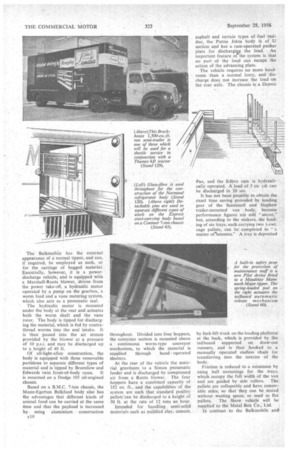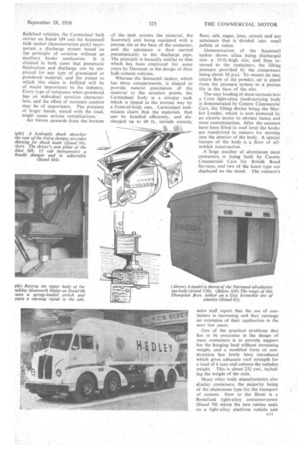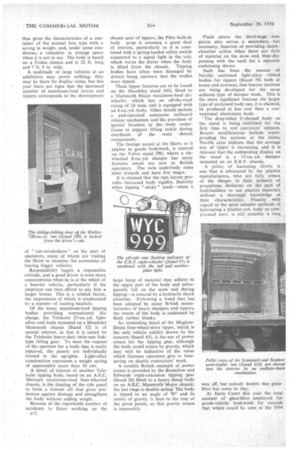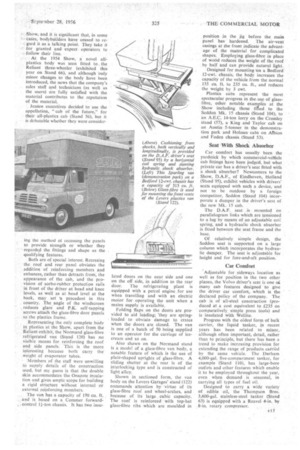BULK'S THE THING
Page 75

Page 76

Page 77

Page 78

Page 79

If you've noticed an error in this article please click here to report it so we can fix it.
says P. A. C. Brockington, A.M.I.Mech.E. HIGH labour costs have stimulated the development of goods bodies. -as the Show reveals. The objects of providing greater payload capacity and reducing terminal difficulties are directly related to the labour problem, and even the use anew materials, such as glass-fibre, is encouraged by the possibility of reducing repair times, quite apart from any saving in production costs, which may be a secondary
consideration. .
The yardsticks of economy are the manlhours-per-ton to deliver the :goads and the job-hours to keep the' vehicle running. The larger the vehicle for a given mileage, the greater the saving, if adequate terminal facilities are provided for handling the load.
Examining the vehicles which exernplifY scientific handling, it is evident that many hauliers, as well as large Cdicence operators, must take advantage of the latest developments if they are to provide transport that is economic by. modern standards. If they are deterred by complexity and a higher first cost, they may lose their livelihood.
• The new Durarnin Bulkrnobile tipper on Stand 48 and the Mann Egerton Bulkfeed hopper vehicle. (Stand • 82) indicate different approaches to ,the problem of discharging any type . of animal feeding-stuffs with the minimum delay by means of a blower-feeder system, whereas the Piston Jekta body, displayed by County Commeecial Cars,
on Stand 123, is a well-tried system applied for the first time to a shortwheelbase chassis.
Mechanism fitted to the Scainmell and Nephew van body mounted on a Carrimore 5-6-ton trailer (Stand 112) for the rapid loading of cage-type pallets is simple by contrast, but betokens a design ingenuity based on a realistic appreciation of terminal efficiency.
The Bulkmobile has the external appearance of a normal tipper, and can, if required, be employed as such, or for the carriage of bagged material. Essentially, however, it is a powerdischarge vehicle, and is equipped with a Marshall-Roots blower, driven from the power take-off, a hydraulic motor operated by a pump on the gearbox, a worm feed and a vane metering system, which also acts as a pneumatic seal.
The hydraulic motor is mounted under the body at the rear and actuates both the worm shaft and the vane rotor. The body is tipped for discharging the material, which is fed by contrathread worms into the seal intake. it is then passed into the air stream provided by the blower at a pressure of 10 p.s.i. and may be discharged up to a height of 40 ft.
Of all-light-alloy construction, the body is equipped with three removable partitions to separate different types of material and is tipped by Bromilow and Edwards twin front-of-body rains. It is mounted on a Dodge 105 oil-engined chassis.
Based on a B.M.C. 7-ton chassis, the Mann-Egerton Bulkfe,ed body also has the advantages that different kinds of animal food can be carried at the same time and that the payload is increased by.. using aluminium construction E 0 throughout. Divided into four hoppers, the container section is mounted above a continuous worm-type conveyor mechanism, to which the material is supplied through hand operated shutters.
At the rear of the vehicle the material gravitates to a Simon pneumatic feeder and is discharged by compressed air from a Roots blower. The four hoppers have a combined capacity of 352 cu. ft., and the capabilities. of the system are such that standard poultry pellets'can be discharged to a height of 50 ft. at the rate of 12 tons an hour.
Intended for handling semi-solid materials such as padled clay, cement. asphalt and certain types of fuel residue, the Piston lekta body is of U section and has a ram-operated pusher plate for dischargiv the load. An important feature ot the system is that no part of the load can escape the action of the advancing plate.
The vehicle requires no more headroom than a normal lorry, and discharge does not increase the load on the rear axle. The chassis is a Dennis Pax, and the Edbro ram is hydraulically operated. A load of 5 cu. yd. can be discharged in 20 see.
It has not been possible to obtain the exact time saving provided by loading gear of the Scammell and Nephew trailer-mounted van body, because performance figures are still " secret," but, according to the makers, the loading of six trays, each carrying two +-cwt. cage pallets, can becompleted in " a matter ofsrninutes." A tray is deposited
by fork-lift truck on the loading platform at the back, which is provided by the tailboard supported on draw-out runners, and is then _hooked to a manually operated endless chain for transferring into the interior of the body.
Friction is reduced to a minimum by using ball mountings for the trays, which occupy the full. width of the van and are guided by side rollers. The pallets are collapsible and have removable sides, so that they can be stored without wasting space, or used as flat pallets. The Show vehicle will be supplied to the Metal Box Co., Ltd. , In contrast to the Bulkmobile and Bulkfeed vehicles, the Carmichael bulk carrier on Stand I09 and the Scammell bulk tanker (demonstration park) incorporate a discharge system based on the principle of aeration without an auxiliary feeder mechanism. It is claimed in both cases that pneumatic fluidization and discharge can be employed for any type of granulated or powdered •material, and the extent to which this claim is fulfilled will be of major importance to the industry. Every type of substance when powdered has an individual aeration characteristic, and the effect of moisture content may be of importance. The presence of larger lumps, mixed with the load, might cause serious complications. '
Air blown upwards from the bottom of the tank aerates the material, the Scammell unit being equipped with a porous tile at the base of the container, and the substance is then carded pneumatically to the discharge pipe. The principle is basically similar to that which has been employed for some years by Duramin in the design of their bulk-cement vehicles.
Whereas the Scaminell tanker, which has three compartments, is shaped to provide natural gravitation of the material to the aeration points, the Carmichael body is a circular tank which is tipped in the normal way by a front-of-body ram. Carmichael technicians claim that the materials that can be handled efficiently, and discharged up to 40 ft., include cement, flour, salt, sugar, lime, cereals and any substance that is divided into small pellets or cubes.
Demonstration of the Scammell tanker shows silica being discharged into a 35-ft.-high silo, and then returned to the containers, the .lifting pressure provided by the compressor being about 30 p.s.i. To ensure an easy return flow of the powder, air is piped from the pressure system to a porous tile in the base of the silo.
The easy loading of meat carcases into a Litex light-alloy food-carrying body is demonstrated by County Commercial Cars, the lifting device being the Market Loader, which is now powered by an electric motor to obviate fumes and meat contamination. After the carcases have been lifted to roof level the hooks are transferred to runners for moving into the interior of the body. A special feature of the body is a floor of allwelded construction.
'large number of aluminium meat containers, is being built by County Commercial Cars for British Road Services, and two of the latest type are displayed an the stand. The concern's sales staff report that the use of containers is increasing and they envisage an extension of their application in the next few years.
One of the practical problems that has to be overcome in the design of meat containers is to provide support for the hanging load without increasing weight, and a modified form of construction has lately been introduced which gives adequate roof strength for a load of 6 tons and reduces the unladen weight. This is about 23: cwt., including the weight of the rails.
Many other body manufacturers also display containers, the majority being of the aluminium type for the transport of cement. New to the Show is a Bonallack light-alloy container-cover (Stand 70) which fits into rubber seals on a light-alloy platform vehicle and
thus gives the characteristics of a container of the normal box type with a saving in weight, and, under. some conditions, a reduction in storage space when it is not in use. The body is based on a Foden chassis and is 22 ft. long and 7 ft. 9 in. wide.
A multitude of large vehicles at an exhibition may prove nothing; they may be there for display value, but this year there are signs that the increased number of maximum-load lorries and tippers corresponds to the development of " size-mindedness " on the part of operators, many of whom are visiting the Show to examine the economics of buying bigger vehicles.
Responsibility begets a responsible attitude, and a good driver is even more conscientious when he is at the wheel Of a heavier vehicle, particularly if his employer can then afford to pay him a larger bonus. This is a related factor, the importance of which is emphasized by a number of leading hauliers.
Of the many maximum-load tipping bodies providing conventional discharge, the Telehoist 27-cu.-yd. lightalloy coal body mounted on a Maudslay Mammoth chassis (Stand 52) is of special interest, in that it is raised by the Telehoist heavy-duty twin-ram linktype lifting gear. To meet the request of the operator for a body that is easily repaired, the panels are individually riveted to the uprights. Light-alloy construction represents a weight saving of appreciably more than 10 cwt.
A detail of interest of another Telehoist tipping body, based on an A.E.C. Mercury maximum-load four-wheeled chassis, is the shaping of the side panel to form a bottom sill that gives protection against damage and strengthens the body without adding weight.
Because of the regrettable number of accidents to fitters working on the El 2 chassis gear of tippers, the Pilot built-in body prop is arousing a great deal of interest, particularly as it is combined with a spring-loaded safety switch connected to a signal light in the cab, which warns the driver when the body is lifted from the chassis. Tipping bodies have often been damaged by drivers being unaware that the bodies were tipped.
These tipper features are to be found on the Maudslay stand (60), fitted to a Mammoth Major maximum-load sixwheeler, which has an off-the-road rating of 24 tons, and is equipped with an 8-cu.-yd. body. Other details include a pad-operated automatic tailboard release mechanism and the provision of special brackets in the body underframe to support lifting tackle during overhauls of the main chassis components.
The foreign accent at the Show, as it applies to goods bodywork, is centred on the Volvo stand (98), where a sixwheeled 8-cu.-yd. dumper has many features which are new to British operators. The twin underbody rams slant inwards and have five stages.
It is claimed that the ram layout provides increased body rigidity. Stability when tipping " sticky " loads—when a large lump of material may adhere to the upper part of the body and subsequently fall on the scow end during tipping—is ensured by a hydraulic shock absorber. Following a trend that has been adopted by many British manufacturers of heavy dumpers and tippers, the return of the body is cushioned by thick rubber blocks.
An interesting detail of the MagirusDeutz four-wheel-drive tipper, which is the only vehicle exhibit shown by the concern (Stand 65), is the use of power return for the tipping gear, although the body could return by gravity, which may well be indicative of the value which German operators give to timesaving on shuttle contractors' work.
A notable British example of power return is provided by the Bromilow and Edwards triple-extension tipping gear (Stand 26) fitted to a heavy dump body on an A.E.C. Mammoth Major chassis; the last stage is double acting. The body is tipped to an angle of 70° and its centre of gravity is then to the rear of the pivot points, so that gravity return is impossible. .
Fluid above the third-stage .ram piston also serves a secondary, . but necessary, function of providing.shockabsorber action when there are falls of Material on the scow end, thtts,dispensing with the need for •a separate cushioning device.
Such has been the success of Neville sectioned light-alloy ribbed bodies for tippers (Stand 78) both at home and overseas, that heavier sections are being developed for the most arduous type of dumper work. This is the more significant because the larger type of sectioned body can, it is claimed, be produced at less cost than a conventional aluminium body.
'The drop-sided U-shaped body on the stand is being exhibited for the first time to test operators' opinion. Recent modifications include waterproofing the sections at the joints. Neville sales indicate that the average size of tipper is increasing, and it is relevant that the outstanding display on the stand is a 15-cu.-yd. dumper mounted on an E.R.F. chassis.
A policy of hastening slowly is one that is advocated by the plastics manufacturers, who are fully aware of the danger to their industry of precipitous decisions on the part of bodybuilders to use plastics materials without a thorough knowledge of. their characteristics. Finality with regard to the most suitable methods of fabricating a plastics cab, body or complicated part, is still possibly a long way off, but nobody doubts that glassfibre has come to stay.
At Earls Court this year the total amount of glass-fibre employed for goods-vehicle bodywork far exceeds that which could be seen at the 1954 Show, and it is significant that, in some • cases, bodybuilders have ceased to re-• • ' gard it as a talking point. They take it for granted and expect operators to follow their line.
. At the 1954 Show, a novel allplastics body was seen fitted to_. the Reliant three-wheeler (exhibited this year on Stand 66), and although -only minor changes to the body have been introduced, the news that the company's sales staff and technicians (as well as the users) are fully satisfied with the material contributes to the reputation of the material.
JenSen executives decided to use the appellation, "cab of the future," for their all-plastics cab (Stand 56), but it is debatable whether they were consider.
ing the method ot recessing the panels to provide strength or whether they regarded the fittings and shape as the qualifying features.
Both are of special interest. Recessing the roof and rear panel obviates the addition of reinforcing members and enhances, rather than detracts from, the appearance of the cab, and the provision of sorbo-rubber protection rails in front of the driver at head and knee levels, as well as at head level at the back, may set 'a precedent in this country. The angle of the windscreen reduces glare and P.K. self-tapping screws attach the glass-fibre door panels to the plastics frame.
Representing the only complete body in plastics at the Show, apart from the Reliant exhibit, the Normand glass-fibre refrigerated van (Stand 120) has no visible means for reinforcing the roof and side panels. This is the more interesting because both carry the weight of evaporator tubes.
Members of the staff were unwilling to supply details of the construction used, but my guess is that the double skin accommodates the Onazote insulation and gives ample scope for building a rigid structure without internal or external reinforcing members.
The van has a capacity of 190 Cu. ft. and is based on a Commer forwardcontrol 11-ton chassis. It has two inso kited doors on the near side and one on the off side, in addition to the rear door. The refrigerating plant is equipped with a petrol engine for use when travelling and with an electric motor for operating the unit when a mains supply is available.
Folding flaps on the doors are provided to aid loading; 'they are springloaded to obviate damage to crates when the doors are closed. The van is one of a batch of 50 being supplied to an operator for the carriage of icecream and so on.
Also shown on the Normand stand is a model of a glass-fibre van body, a notable feature of which is the use of plate-shaped uprights of glass-fibre. A sliding shutter at the rear is of the interlocking type and is constructed of light alloy.
Shown in sectioned form, the van body on the Levers Garages' stand (122) commands attention by 'virtue of its glass-fibre roof and wheel-arches, and because of its large cubic capacity. The roof is reinforced with top-hat glass-fibre ribs which are moulded in position in the jig before the main panel has hardened. The air-vent casings at the front indicate the advantage of the material for complicated shapes. Employing glass-fibre in place of wood reduces the weight of the roof by half and can provide naturalfight.
Designed for mounting ton a Bedford 12-cwt. chassis, the body increases the capacity of the vehicle from the normal 135 Cuft. to 235 Cuft., and reduces the weight by 3 cwt.
Plastics cabs represent the most spectacular progress in the, use of glassfibre, other notable examples at the Show including those lined . to the Seddon Mk. 15 chassis (Stand 104), to an A.E.C. 14-ton lorry on the Crossley stand (57), a King and Taylor cab on an Austin 5-tormer in the demonstration park and Holmes cab S on Afbion and Foden chassis (Stand 53).
Seat With Shock Absorber
Car comfort has usually been the yardstick by which commercial-vellicle cab fittings have been judged, but what private' car has a driver's seat fitted with a shock absorber? Newcomers to the Show, D.A.F., of Eindhoven, Holland (Stand 95), exhibit vehicles with drivers' seats equipped with such a device, and not to be outdone by a foreign competitor, Seddon (Stand 104) incorporate a damper in the driver's seat of the new Mk. IS cab.
The D.A.F. seat is mounted on parallelogram links which are tensioned to a lug by means of an adjustable coil spring, and a hydraulic shock absorber is fitted between the seat frame and the base.
Of relatively simple design, the Seddon seat is supported on a large column which incorporates the hydraulic damper. The seat is adjustable for height and for fore-and-aft position.
Car Comfort
'Adjustable for sideways location as well as for position in the two other planes, the Volvo driver's seat is one many cab features designed to give the driver car comfort, which is the declared policy of the company. The cab is of all-steel construction (produced at a cost equivalent to £235 on comparatively, simple press tools) and is insulated with Wellite.
Progress with the oldest form of bulk carrier, the liquid tanker, in recent years has been related to minor, although often important, detail, rather than to principle, but there has been a trend to make increasing provision for extending the range of products carried by the same vehicle. The Darham 4,000-gal. five-compartment tanker, for example (Stand 110), has large-bore outlets and other features which enable it to be employed throughout the year, even when demand is seasonal, in carrying all types of fuel oil.
Designed to carry a wide variety of edible oil, the Thompson Bros. 3,600-gal. stainless-steel tanker (Stand 63) is equipped with a Reavel 4-in. by 8-in, rotary compressor.




































































































































































